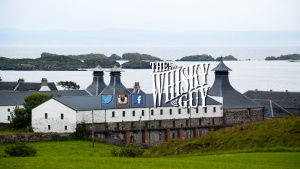Welcome to Episode #7 of The Whisky Guy Podcast, featuring George Grant from Glenfarclas!
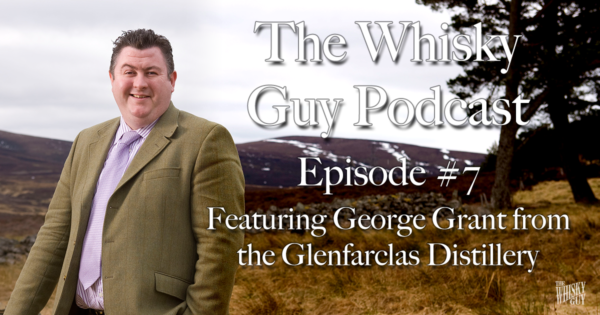
George Grant – 6th Generation Distiller Owner and Manager at Glenfarclas on The Whisky Guy Podcast Episode #7
It’s Whisky Wednesday – Time for a dram!
Published Dec 9, 2015
In this episode of The Whisky Guy Podcast:
Live from Washington DC – Hello YouTube!
After Repeal Day celebrations till the wee hours on Saturday, I was up early Sunday for a flight to Washington DC for a visit to the Catoctin Creek Distillery. In an upcoming episode of the podcast you’ll hear from Scott at Catoctin Creek about the history of the distillery and their rye-based spirits, but right now you can see a tour of their distillery. Visit The Whisky Guy on YouTube – Part 1 is up already and Part 2 will be added shortly, with lots more videos to come. Please Subscribe to The Whisky Guy on YouTube and give the videos a Thumbs Up!
Thank You Patrons!
The Whisky Guy is listener supported! It’s free and ad-free because of Patrons through the Patreon crowdfunding platform. Becoming a Patron is fast and easy. As low as $1 per episode lets you walk a little taller, knowing you’re supporting The Whisky Guy and keeping all the great info coming, and also keeps The Whisky Guy free and ad-free. Learn more about my Patreon campaign, and become a Patron today by visiting The Whisky Guy on Patreon. Thank You Patrons!

Your support keeps The Whisky Guy free and ad-free. Become a Patron today!
Interview with George Grant of Glenfarclas Distillery
One of the few remaining independent distilleries in Scotland, Glenfarclas now has its 6th generation owner – George Grant – traveling the world and talking about his family’s distillery. He was in Seattle in early November for a tasting with members of the Washington State Bartenders Guild (a USBG chapter). I had a chance to sit with him for a short interview before a tasting that lasted over an hour. The tasting will be broken into 2 episodes; Part 1 today will cover Glenfarclas 10, 12, and 17 year old. Part 2, which will release early 2016 in episode 9 of The Whisky Guy Podcast, will cover the 21 and 25 year old, and the 105 Proof. This episode is best listened to on headphones; some of the questions from the audience are a little quiet. Also, I was live tweeting using #GlenfarclasWA – another way to follow along!
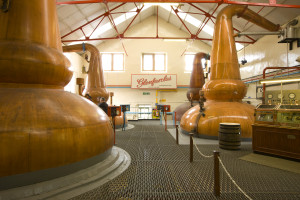
The Still house at the Glenfarclas Distillery
Interview
- George Grant is 6th Generation owner of the Glenfarclas distillery, and current Director of Sales
- George’s first time in Seattle in 7-8 years
- Distillery roots are a little unknown – First license to distill was in 1836 tho records go back much further; at least 1791 and likely earlier
- John Grant family purchased the distillery on June 8, 1865, 150 years ago
- Sales price was £511.19; approximately $800 in today’s US dollars
- After John Grant, in succession, was George, then George, then George, then John, and today – George
- With the birth of Prince William and Kate’s son George, “after 36 years, my name is finally cool”
- George Grant has 2 daughters – Kaitlyn and Sofie
- Distilleries across Scotland (and around the world) all have unique selling points – 2 things make Glenfarclas special:
- Largest stills in Speyside with direct fire heated stills
- Only using dunnage-style warehouses, keeping casks to a limit of 3 high which helps all casks mature at the same rate
- Excited to see global whiskies growing – new distilleries coming online helps more people appreciate whisk(e)y
- The average blended whisky drinker will have 1 bottle at home – the average malt whisky drinker will have 12 bottles at home
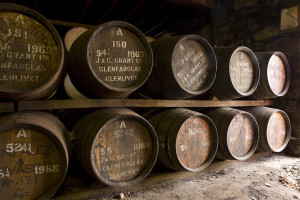
Casks rest in the maturation warehouse at the Glenfarclas Distillery
Tasting
- Recap of history covered in the interview
- Best guess is the distilleries was build in the 1750’s
- Some bottles of Glenfarclas sell today for 40x the purchase price of the distillery in 1865
- Glenfarclas whisky is sold in over 100 countries, with Germany being the top 2 markets – both domestic sales and duty free
- Growth is strong globally. 36 new distilleries just opened or opening soon in Scotland
- Whisk(e)y drinkers are easy to buy gifts for
- At WhiskyFest in New York, a group of gentlemen stopped by the Glenfarclas table for their first taste after walking past others, just because it had the word ‘Glen’ in the name
- Glenfarclas is matured in Oloroso sherry casks
- Distillery is in Speyside, and has both the words Highland and Speyside on the label
- Speyside, as a named region, has only existed since 1972 – many distilleries in the region have the word Highland, even though they sit in Speyside, after Glenlivet distillery took ownership of the name for which many of the distilleries in the area were adding to their title. For example, Glenfarclas was Glenfarclas Glenlivet for some time
- Part of the name change was to limit confusion over ownership
- All Speyside whiskies are Highland, but not all Highland whiskies are Speyside
- Location hasn’t changed – on a slight slope that helped gravity-feed the stills until electricity was more common
- Only Water, Malted Barley and Yeast go into making malt whisky, and the water is the only truly unique ingredient
- Glenfarclas stopped doing their own maltings in 1972
- First taste – Glenfarclas 10 year old
- No added color in Glenfarclas whiskies – all color from the Oloroso Sherry casks, from Jerez, Spain
- Sherry casks are approx 10x the cost of Bourbon casks
- Glenfarclas uses a combination of 60% 1st and 2nd fill casks, and 40% 3rd and 4th fill casks married together
- 10 year is balanced but has a short finish
- “Good every day drinking whisky”
- Difficult to sell for a while in the US as it was lower proof than many other Scotch whiskies sold, but 40% is more common today
- Many distilleries are removing age statements, but Glenfarclas still has theirs even at 10 years
- George is sad about the loss of age statements across the industry
- Scotch whisky growth is helping Glenfarclas, as is the global growth of the internet allowing people to do their own research and find smaller brands like Glenfarclas
- Whisky makes a great gift for hosts at dinner parties as it lasts longer/goes further
- Glenfarclas is a ‘typical Speyside whisky’ – palatable, non-aggressive, not peated, easy to drink
- Some distilleries in Speyside are experimenting with peated barley and casks
- Second Taste – Glenfarclas 12 year old
- George’s pick to represent the essence of Glenfarclas
- Glenfarclas translates to ‘Valley of Green Grass Land’
- Grassy-ness and sweetness, with dried fruit
- Surprising departure from the 10, especially in the finish – a much longer finish
- Creme Brule, Vanilla and Caramel flavors – a ‘bigger, longer whisky’
- 12 year old is export only – not sold in the UK at all. UK has 10 and 15 where US has 12 and 17 year old
- Late 60’s Glenfarclas bottlings have a slight peat influence, mostly as it was used as a fuel source but not introduced intentionally
- Peat in Speyside is much different than Islay peat – much lighter
- George tried his hand working as an accountant before going into whisky, first as a Maltster, then for Inver House distillers at Old Pulteney, Speyburn, Balblair and AnCnoc distilleries before Glenfarclas
- Working at Glenfarclas is not a right when being born into the Grant family – by George’s great grandfather’s decree, you must work at another distillery before working at Glenfarclas, so ‘any mistakes you make are made at someone else’s distillery’
- George worked in Hong Kong circa 1998 as a salesman
- Glenfarclas 10 and 12 are ‘before dinner drinks’ – 17 year old ‘covers all the bases
- Third Taste – Glenfarclas 17 year old
- Good before, during or after dinner
- Still has some of the aggression of a younger whisky, but has the depth and finesse of an older whisky. Very balanced.
- Only sold in North America and Asia
- Started as a Japan exclusive to limit discounting sales through importing from cheaper markets
- George buys bottles when he travels as he can’t purchase it at all in the UK, even as the owner
- Flavor – Eating cotton candy. Sweetness dancing across the tongue. Toffee, marmalade zestiness, typical Glenfarclas bitter chocolate finish
- Question: Please speak to the age statement issue and distilleries removing the age statement
- Answer: Mostly about having trouble growing and not having enough stock, true at Glenfarclas as well, tho Glenfarclas has chosen to drop expressions from the line-up entirely or limit the bottles to certain regions instead of removing age statements. Distilleries have little incentive to re-introduce age statements after replacing them with lower production cost whiskies.
- Question: Where does the slight peat character in the tasting notes come from in Glenfarclas if it’s a non-peated whisky?
- Answer: Aside from George smoking, just by malting barley you get approx 3 parts per million of peat in the grain.
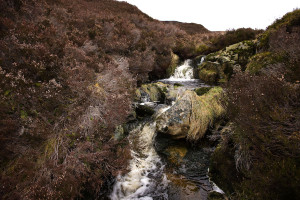
The unique watersource for whisky making at the Glenfarclas Distillery
End of Part 1 of the tasting with George Grant – Episode 9 of The Whisky Guy Podcast will have part 2 of the tasting. After the tasting, George conducted a 20 minute Q&A session. The audio from that session is available to Patrons; lean how to keep The Whisky Guy free and ad-free while also getting access to that sort of exclusive content by becoming a Patron of The Whisky Guy here. Thank You to George Grant, The Glenfarclas Distillery and the Washington State Bartenders Guild for letting me sit in! Find George and the Glenfarclas Distillery on Facebook, Instagram, Twitter and on the web.
Tasting Notes: Aberlour 12 Double Cask Matured
Disclosure – I’ve done paid ambassador work for Aberlour
The color of the whisky and its viscosity are very exciting. A medium amber with long, stick legs. The aroma really highlights the sherry cask influence of the whisky – Cardamom, Tamarind, and late-season dark tree fruits. On the palate it has a great medium creaminess to it and a nice medium finish, but diluting the whisky brings out some challenges.
At approx. $50 and 40% ABV, it packs a lot of flavor, depth and complexity and earns a regular place on the second shelf.
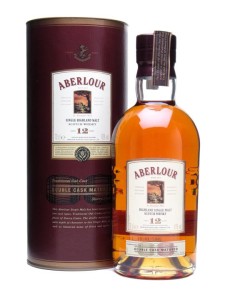
Aberlour 12 Double Cask Matured – Single Malt Scotch Whisky
Connect with The Whisky Guy Socially!
- Find The Whisky Guy on Twitter
- Find The Whisky Guy on Facebook
- Find The Whisky Guy on Instagram
- Find The Whisky Guy on Pinterest
- Find The Whisky Guy on YouTube
Next time on The Whisky Guy Podcast…
Look for episode 8 in 2 weeks, on December 23, 2015, when I’ll speak with Joshua Hatton and Jason Johnstone-Yellin, both whisk(e)y bloggers and co-founders of the Single Cask Nation, about their processes for tasting whisk(e)y. Subscribe to The Whisky Guy podcast today so the episode downloads automatically!
Happy Jerry Thomas Day!
December 15 is Jerry Thomas Day – the anniversary of his death. Jerry Thomas is considered by many to be the first ‘celebrity bartender’ – head to your local that day and order a Blue Blazer, one of his signature drinks.
Sláinte!
